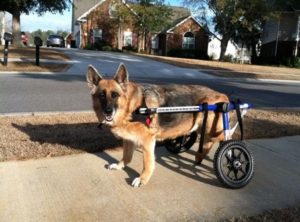
Degenerative myelopathy (DM), also known as chronic degenerative radiculomyelopathy (CDRM), is a progressive disease that affects the spinal cord of dogs, leading to hind limb weakness and paralysis over time. This debilitating condition is similar to amyotrophic lateral sclerosis (ALS), commonly known as Lou Gehrig’s disease, in humans. While the exact cause of DM remains unknown, a genetic mutation called SOD-1 has been identified as a major risk factor. This article aims to provide a comprehensive understanding of degenerative myelopathy in dogs, including its clinical signs, diagnosis, treatment options, and prognosis.
Clinical Signs and Symptoms
Early signs of degenerative myelopathy in dogs may be subtle and resemble those of osteoarthritis or hip dysplasia. As the disease progresses, the following symptoms become more evident:
- Hind Paw Knuckling: The hind paws may “knuckle” or turn under, causing the dog to walk on its knuckles, especially while turning.
- Swaying Hindquarters: The dog’s hindquarters may appear to sway while standing still.
- Easy Falling: The dog may fall over easily when pushed from the side.
- Scraping Hind Feet: The hind feet may scrape the ground when walking, leading to hair loss and irritation on the top surface of the feet.
- Difficulty Rising: Dogs with DM often have difficulty getting up from a lying position.
As the disease progresses and the spinal cord degenerates further, these symptoms worsen, eventually resulting in paralysis of the hind end.
Breeds at Risk

While degenerative myelopathy can affect dogs of various breeds, some breeds are more commonly affected than others. German Shepherds, German Shepherd crosses, Siberian Huskies, and Collies have a higher predisposition to developing DM due to the SOD-1 genetic mutation. Other breeds at risk include Bernese Mountain Dogs, Boxers, Chesapeake Bay Retrievers, Golden Retrievers, Kerry Blue Terriers, Miniature Poodles, Nova Scotia Duck Tolling Retrievers, Pembroke Welsh Corgis, Pugs, Rhodesian Ridgebacks, Standard Poodles, Welsh Corgis, Welsh Corgi Cardigans, Welsh Corgi Pembrokes, and Wirehaired Fox Terriers.
Age of Onset
Degenerative myelopathy typically occurs in middle-aged to older dogs, with an age range of 4-14 years. However, it can rarely affect young dogs as well. Being aware of the age of onset can help in early detection and management of the disease.
Causes and Genetic Testing
While the exact cause of degenerative myelopathy is still unknown, genetics play a significant role. The SOD-1 mutation is strongly associated with the development of DM. DNA testing through the Orthopedic Foundation for Animals can determine whether a dog is clear of DM, a carrier of the mutation, or at a higher risk of developing the disease. It is crucial for at-risk breeds to undergo genetic testing before breeding to prevent the transmission of the abnormal gene.
Diagnosing Degenerative Myelopathy

Diagnosing degenerative myelopathy in dogs can be challenging and time-consuming. The process involves a thorough examination of the breed, medical history, physical examination, and diagnostic tests. X-rays and spinal imaging techniques are often used to rule out other conditions such as hip dysplasia and chronic arthritis. Cerebrospinal fluid analysis, tissue biopsies, and neuromuscular tests may also be conducted. DNA testing for the SOD-1 mutation is recommended for at-risk breeds showing clinical signs consistent with DM. Histopathology of the spinal cord is required for a definitive diagnosis.
Bowel and Bladder Function
In the early stages of degenerative myelopathy, bladder and bowel function are generally normal. However, as the disease progresses and paralysis sets in, dogs may develop urinary and fecal incontinence.
Pain and Treatment Options
Most dogs with degenerative myelopathy do not experience pain but rather extreme weakness. If a dog appears to be in pain, another condition such as arthritis may be complicating the situation. While there is currently no cure for DM, treatment primarily focuses on managing concurrent problems such as arthritis or hip dysplasia to provide relief from discomfort. It is crucial to maintain a healthy weight through proper diet and exercise, including walking and swimming. Physical therapy has shown promising results in prolonging quality of life and preserving muscle mass. A combination of epsilon-aminocaproic acid, N-acetylcysteine, prednisone, vitamins B, C, and E, and exercise therapy may slow down the progression of clinical signs.
Prognosis and Quality of Life

Unfortunately, degenerative myelopathy is a progressive and incurable disease. As the spinal cord continues to degenerate, the dog’s mobility becomes severely restricted, leading to difficulty in controlling urination and defecation. The prognosis and quality of life depend on the nature and temperament of the affected dog. Mobility aids, such as paraplegic carts, may improve the dog’s short-term quality of life. However, the disease will inevitably progress, and the symptoms will worsen over time. Veterinarians assess each dog’s circumstances individually to determine the most appropriate treatment options.
Conclusion
Degenerative myelopathy is a challenging disease that affects the spinal cord of dogs, leading to hind limb weakness and paralysis. While the exact cause is unknown, genetics play a significant role, and a genetic mutation called SOD-1 has been identified as a risk factor. Early detection and genetic testing are crucial for at-risk breeds to prevent the transmission of the abnormal gene. While there is no cure for DM, managing concurrent problems, maintaining a healthy weight, and incorporating physical therapy can help improve the dog’s quality of life and slow down the progression of clinical signs. Understanding the clinical signs, diagnosis, treatment options, and prognosis of degenerative myelopathy can aid dog owners and veterinarians in providing the best possible care for their beloved pets.
Additional Information: It is essential for dog owners to consult with a veterinarian for an accurate diagnosis and guidance on managing degenerative myelopathy. Regular check-ups and close monitoring of the dog’s condition are crucial to ensure the best possible care and quality of life.
